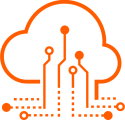
Our partner NEXCOM has introduced its series of Google Coral AI Edge telematics solutions in conjunction with the Edge TPU accelerator. But what does this mean for you?
The collaboration between NEXCOM and Google has created an all-in-one AI ecosystem that supports multiple use cases in public building and transportation. These include condition monitoring and object recognition. Coral enables secure, fast and efficient execution of inference at the edge. This actively avoids the intensive cost and time involved in uploading to a centralized cloud. Currently the following solutions have been enhanced with Coral:
The Coral Edge accelerator: Small but with a lot of power!
Google's Edge AI accelerator ASIC, which has been integrated into selected NEXCOM solutions, is small. Nevertheless, it manages to handle inferences with deep neural networks and large amounts of data. Its compact Mini PCIe form factor makes it:
- space-saving
- energy efficient
- more cost-effective (in direct comparison to other competitors)
For system integrators and developers who already work with other Google Cloud services, this seamless and end-to-end infrastructure integration should be pleasing.
The Google Coral TPUs also use the proprietary open source framework TensorFlow, which enables machine learning. This enables existing and new models to be prepared for use with Google Coral AI Edge telematics solutions. As the framework is used locally on the platform, become:
- shorter loading times
- and less time and more data protection achieved
In practice, this means that modeling and learning tasks can be completed even faster and more reliably.
A partnership for future-oriented transformations
NEXCOM's offering of Google Coral AI accelerator solutions is based on a focus on increasing transportation security and efficiency through in-depth learning. For example, the PoE ports of the telematics gateways support IP cameras to ensure continuous monitoring on board. The same applies to automatic license plate recognition (ANPR) and optical character recognition (OCR).
In the same way, tracking and people counting functions can be integrated into GPS positioning. In this way, valuable data on utilization and usage can be collected without the need for additional personnel. A further security level is created by intelligent sensors. These can learn to detect foreign objects at an early stage to prevent accidents. The control center in turn can use this information to intelligently control traffic at intersections.
All the above-mentioned possibilities show only a fraction of the possibilities that AI can offer in connection with traffic. For the future, this development means that a unified, progressive and intelligent city can be created.
NEXCOM solutions are durable and reliable
The Google Coral AI Edge telematics solutions run on reliable Intel® CPUs (Atom or Core), which have high computing power. Furthermore, the robust computers can also be used in harsh environments. Longevity is guaranteed by vibration and shock standards (MIL-STD-810G) and a wide operating temperature range (-20°C to +60°C). At the same time, the integrated heat sinks and heat dissipators protect the computers from overheating, which occurs especially at high computing loads. All solutions are also easy to install, as Debian Linux fans can be programmed without any problems.

